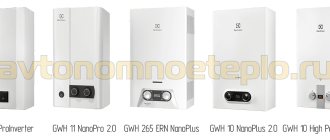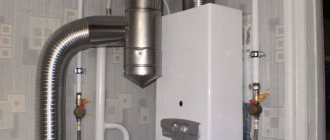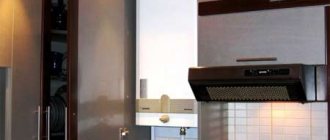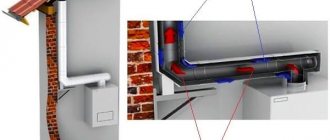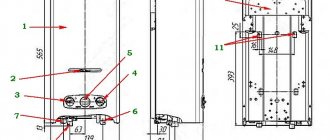A high-quality geyser can provide comfort during water procedures for a long time. When choosing a device, it is important to pay attention to the reputation of the manufacturer. In the domestic market, the leading position in the design of flow-through gas water heaters belongs to the BaltGaz Group concern. One of the models produced by the company is the Neva-4511 geyser, technical characteristics, reviews, advantages and disadvantages of which will be discussed in the article.
Preparing to set up a water heater
Although there are instructions for the Bosch, Selena and Neva gas water heaters on how to set them up correctly, not everyone understands how to do this.
Having made a mistake at the very beginning, the device begins to work not as it should. You should start by regulating the water supply. First of all, adjust the water regulation. If you do it at the last moment, then all the settings will be incorrect. The flow must be the smallest . The values can be found in the documentation, they are usually 6, 10 and 12 liters.
The main thing is that there is only one tap for work.
Starting the device and adjusting the temperature
To correctly set up hot water in the device, you must:
- Open the hot water mixer fully;
- Using the water switch, select the required temperature value;
- Close the tap.
According to the advice of professionals:
- Wait for the moment when the pressure in the line drops, but the column will still work;
- Turn the water toggle handle to the maximum;
- Turn the gas regulator to the minimum value until the temperature is as desired.
For final preparation, it is worth adjusting the gas supply. To do this, you need to look at the technical data sheet and find out the minimum value for this brand.
The toggle switch is turned to the minimum value.
Turn on the gas supply valve. At the gas water heater, Electrolux and Ariston do this after connecting to the network. The Oasis, Junkers and Bosch gas water heaters are connected when the batteries are installed.
The hot valve is turned on and the device starts working.
How to adjust the water temperature
Turn on the mixer and check the water heating temperature. It must be twenty-five degrees more than the original one. It is worth noting that the water in a gas boiler heats up gradually. The geyser is adjusted using the gas lever.
Reference! You can also adjust the temperature using the water toggle switch. If the flow force increases, the heating temperature will decrease.
Professionals do not recommend heating water above fifty-five degrees. This has a bad effect on the device, as scale forms.
Blood pressure problems
Setting up a geyser requires some time. Accordingly, the result will be visible later. After each stage, it is worth pouring out the water and letting it heat up again so that the values are correct. Low pressure in the device may interfere with normal operation.
Speaker manufacturer information
The Baltic Gas Company (BaltGaz Group) has been operating since 1995. Today the concern is the Russian market leader in the development, production and sale of gas water heaters and boilers.
The group includes two large plants: St. Petersburg Gazapparat and Armavir Gas Plant. equipment." The concern sells finished equipment and spare parts wholesale and retail to household and industrial consumers. Sales points are open in more than 1,500 settlements in the Russian Federation and neighboring countries. The number of authorized service centers is more than 400.
BaltGaz Group products combine Russian engineering experience and advanced European technologies. Gas water heaters are produced under the Neva and Neva Lux brands (NEVA and NEVA LUX). The quality of their workmanship and the level of environmental safety meet international standards, and the price is lower than that of foreign analogues.
Criterias of choice
It is necessary to select a product based on the characteristics of the housing communications.
The selection of a suitable Neva device is based on:
- On the water pressure in the house system. In this case, you should focus on the minimum values, for example, in the summer a weak indicator is possible.
- On gas pressure in the area of consumption.
- An important factor is the number of hot water consumption points. More points - a unit with increased power is needed.
- The quality of the supplied water and the source of gas play an important role.
- Be sure to pay attention to the safety level of the speaker you are purchasing.
- How to turn on and configure the Neva gas water heater
Setting up and turning on the Neva geyser depends on the specific model. Before starting operation, you must thoroughly understand the instructions, which describe all the necessary actions. Turning on the device will depend on the built-in ignition system. Regulating the device involves setting set temperature values, water pressure levels and modulating combustion power. Be sure to take into account the time of year, because the stated values differ in winter and summer. We pay attention to the safety sensors to avoid any problems with use.
. INDICATION OF SAFETY PRECAUTIONS…………………………….
Page 2
- Image
- Text
2
CONTENT
1.
INDICATION OF SAFETY PRECAUTIONS ………………………………………………………………………………………. 3
2.
DESCRIPTION AND OPERATION OF THE DEVICE ………………………………………………………………………………….. 4
2.1.
Purpose of the device…………………………………………………………………………………………………………………… 4
2.2.
Technical specifications………………………………………………………………………………… 4
2.3.
Scope of delivery ………………………………………………………………………………………………………………….. 5
2.4.
Device design “NEVA-4011”…………………………………………………………………………………. 5
2.5.
Operation of the device “NEVA-4011” ………………………………………………………………………………….. 6
2.6.
Device design “NEVA-4511”…………………………………………………………………………………. 9
2.7.
Operation of the device “NEVA-4511” ………………………………………………………………………………….. 11
3.
INSTALLING THE DEVICE …………………………………………………………………………………………………………….. 12
3.1.
Installation location and diagram ……………………………………………………………………………………… 12
3.2.
Installation of the device……………………………………………………………………………………………………………. 13
3.3.
Connecting the device to the water supply network………………………………………………………………. 13
3.4.
Connecting the device to the gas network…………………………………………………………………………………….. 14
3.5.
Connecting the device to a liquefied gas cylinder ………………………………………………… 14
3.6.
Rules for installing flexible hoses…………………………………………………………………………………. 14
3.7.
Connecting the device to the chimney…………………………………………………………………………………. 15
3.8.
Installation of batteries for the device “NEVA-4511” …………………………………………………………….. 16
3.9.
Checking the device …………………………………………………………………………………………………………………. 16
3.10.
Conversion of the device to a different type and pressure of gas …………………………………………………………… 17
4.
USING THE DEVICE…………………………………………………………………………………………………………… 17
4.1.
Switching on the device “NEVA-4011”…………………………………………………………………………………. 17
4.2.
Turning on the device “NEVA-4511”…………………………………………………………………………………. 18
4.3.
Regulation of temperature and water flow………………………………………………………………………………… 18
4.4.
Turning off the device…………………………………………………………………………………………………………….. 19
4.5.
Replacing the batteries of the device “NEVA-4511” ……………………………………………………… 20
4.6.
Frost protection ……………………………………………………………………………………… 20
4.7.
Actions in case of an emergency………………………………………………………… 20
5.
MAINTENANCE ………………………………………………………………………………………. 20
5.1.
Inspection…………………………………………………………………………………………………………………………………… 21
5.2 .
Care ……………………………………………………………………………………………………………………………. 21
5.3.
Maintenance…………………………………………………………………………………….. 21
6.
POSSIBLE DEVICE MALFUNCTIONS AND METHODS OF THEIR ELIMINATION …………………….. 22
7.
RULES OF TRANSPORTATION AND STORAGE………………………………………………………………. 25
8.
WARRANTY ……………………………………………………………………………………… 26
9.
CERTIFICATE OF ACCEPTANCE …………………………………………………………………………………………………………… 27
10.
NOTE ABOUT THE INSTALLATION OF THE DEVICE AND
CARRYING OUT MAINTENANCE …………………………………………………………… 27
11.
CATALOG OF COMPONENTS ……………………………………………………………………………………….. 28
12.
SERVICE CENTERS FOR MAINTENANCE OF “NEVA” WATER HEATERS ………………… 32
How to adjust the flame of a gas water heater
Another way to set up a gas water heater is to adjust the flame. On the body of semi-automatic and automatic machines there is a handle designed to adjust the gas. With its help, the supply of blue fuel increases and decreases. The power of the device is directly related to this part.
As soon as the flame becomes larger, the gas consumption will be higher and the water will heat up better. Professionals advise changing the gas transmission speed to properly set the burner. As soon as the burning intensity is selected, the knob for changing the water pressure is applied. In order to change the combustion temperature, it is worth changing the “Winter-Summer” mode.
Adjusting the igniter of the gas water heater will help reduce gas costs in semi-automatic machines. The wick is adjusted using the bolt on the pilot burner. You should be careful when making settings. If you reduce the flame of the gas water heater's igniter too much, the device will stop working. If the flame increases excessively, excess gas consumption will occur.
Setting details
These devices have only one geyser temperature regulator. Thanks to it, the heating temperature and power are adjusted. The self-diagnosis system evaluates the operation of the components when turned on. If there are problems, the red light comes on and the device is blocked from starting. Then it is necessary to adjust the water pressure.
Then you need:
- Remove batteries from the compartment;
- Turn off the microswitch;
- Provide a source of electricity;
- Turn on the hot tap and turn on the microswitch;
- The pressure on the burner should be maximum;
- After saving the settings, the orange lamp will turn on.
In other columns, the water temperature is adjusted by turning the toggle switch and controlling the strength of the water flow.
Important! When adjusting, it is prohibited to exceed the maximum temperature specified in the instructions.
Unfortunately, it is impossible to easily set the settings according to the instructions. Each system has different meanings. If you have difficulties setting up the gas water heater temperature regulator with your own hands, you should turn to professionals.
Gas supply regulation
To prepare the gas path for operation, set the gas supply regulator on the device body to the minimum level. By connecting the equipment to the network or inserting batteries into the column, you can open the tap on the gas pipe. Next, after opening the hot water tap, the device will turn on automatically and begin heating the water.
To continue setting up, get tools that can measure water temperature. Your goal is to set the gas supply regulator handle in a position where the temperature of the hot water flowing from the tap will be 25ºC higher than the temperature of the water entering the column from the water supply. However, remember that gas equipment does not heat water instantly, so you should wait a little to measure the water temperature.
Next, you can change the temperature of the hot water coming from the tap only with a handle that changes the water pressure. As the pressure decreases, the water will move more slowly inside the column and, accordingly, will heat up more.
When adjusting, do not forget to take into account the maximum water heating temperature specified in the instructions, which it is advisable not to exceed.
In the next video you can see and hear some interesting facts about the settings and adjustment of geysers.
Neva 4511, 4513, lux 5611, how to work with the devices.
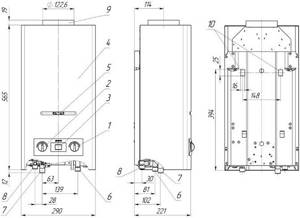
1 – handle for regulating water flow; 2 – handle for regulating gas flow; 3 – display showing water temperature; 4 – facing; 5 – inspection hole; 6 – cold water supply fitting, G ½ thread; 7 – gas supply fitting, G ½ thread; 8 – hot water outlet fitting, G ½ thread; 9 – pipe of the gas exhaust device; 10 – mounting holes.
Turning on the devices:
- First you need to insert the batteries.
- Open the gas valve.
- Open the cold water tap.
- Place handles 1 and 2 (see figure above for model 4511, Neva lux 5611) to the minimum position.
- Turn on the hot water tap. At this time, sparking occurs between the candle and the burner, then the burner lights up and water heating begins.
- Check visually whether the burner is burning.
The water flow rate is adjusted using handle No. 1, and its temperature is adjusted using handle No. 2 (for model 4511). The operating rules for geysers Neva 4511 and Neva Lux are set out here.
From the experience of users for the Neva Lux 5611 model, during initial ignition or after a long shutdown, the burner will ignite if all air is removed from the gas systems. Due to the fact that the spark ignition lasts about 8 seconds.
After opening a hot water tap, to prolong ignition, the tap must be closed and then opened again. This should be done until the final release of air from the pipes, until the burner is ignited.

Geysers Neva Lux 4511, 4513, 5611
For model 4513, temperatures can be adjusted in the following ways:
- Turn the device lever counterclockwise, this will lead to an increase in temperature, and, accordingly, clockwise to a decrease.
- Dilute the water directly with the mixer.
- Change the flow of water passing through the device using a water tap. An increase in flow will lead to a decrease in temperature and vice versa.
Poor pressure
Let's look at what affects the water pressure in a gas water heater:
- Presence of blockages. Every pipe through which water moves tends to become clogged with debris. If we take an Electrolux geyser as an example, the blockage occurs in the mesh filter filled with lime and rust. If the water flow is low, the pressure will be minimal.
- Engineering works. In this case, scale appears inside the heat exchanger. When the water is shut off and the water unit of the gas water heater resumes operation, a “water hammer” occurs, after which some of the scale penetrates into the mixer and forms a blockage.
- Device power. For Bosch geysers and other models, the power of the device is important. It will create good pressure in the system. If the power of the device is less than eight, then the pressure will be minimal. For good operation of the geyser water unit, it is worth purchasing a device with a power of eight to ten kilowatts.
- Scale. It usually occurs in metal containers in which water is brought to a boil. In a gas water heater, the heat exchanger is considered a tank. With hard water, scale forms on its walls, which subsequently moves into the tubes, due to which the pressure decreases.
- Preventive actions. Any device, including a geyser, needs regular maintenance, namely the prevention of blockages. In most cases, a decrease in water pressure occurs due to careless use of the device.
No hot water pressure in the geyser - how to fix it
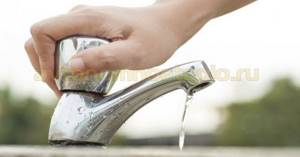
For normal operation of the geyser, a stable water pressure in the supply pipeline is required. When the pressure decreases, the sensors are triggered, the water heater stops working and refuses to turn on. If the instantaneous boiler continues to operate, then severe overheating of the hot water supply is observed. Even with minimal power settings, the column produces more than 50°C, which negatively affects comfort while washing dishes and bathing.
There are two main malfunctions that water heater owners encounter: low pressure of hot water from the gas water heater and insufficient pressure in the pipeline even before entering the boiler. If desired, you can eliminate the causes of the malfunction and ensure stable operation of the equipment.
Main causes of malfunction and their elimination
The designs of all geysers are similar to each other. Why not summarize all the problems and describe options for solving them? Because each brand has its own weaknesses. This is when malfunctions specific to specific brands appear. We analyzed user reviews to collect reliable information for you.
Factory defects in Oasis water heaters are extremely rare.
The cause of failure can be external and internal factors:
- Incorrect installation and connection.
- Incorrect operation.
- Blockages in the chimney and ventilation.
- Problems with internal components: scale, corrosion.
We have described ways to resolve these problems below.
Column does not light up
There can be many reasons, we will help you figure it out. The main thing is to correctly determine the location of the breakdown.
If the device does not ignite at all, no spark is produced, then:
- The batteries are low. Devices with automatic ignition operate on batteries. To replace, take high-quality elements with a good charge. If you find a leak where they are installed, clean all contacts and install new batteries.
- Problems with traction. For normal operation of the equipment, there must be draft in the chimney. If it is not there, inspect the ventilation hole for blockage. It could be a foreign object, soot or debris from the street. If possible, clean the hole. Make sure that the chimney outlet from the outside is not blocked.
How do you know if you have cravings? Light the match and bring it to the viewing window of the column. The flame deviates - there is draft; it burns evenly - no. You can also lean a sheet of paper against the ventilation. If there is traction, the sheet will press against the output, otherwise it will fall.
- The water pressure regulator is set to the minimum level. A small pressure is created in the system to trigger the membrane and open the gas valve. Set the regulator to the maximum value.
- Low pressure in the line. Does a thin stream flow when you open the tap? Contact the water utility and wait for the supply to be restored. If this happens often, it is recommended to install a circulation pump.
- The strainer is clogged. The part is located at the entrance to the water unit and traps small debris that comes with the water flow. You need to disassemble the unit and rinse the filter under running water.
- The membrane has stretched. The element serves to activate the gas valve. When there is pressure in the line, the membrane stretches, pushes out the rod and opens the valve. Over time it wears out and needs to be replaced. You can read about this here: “Geyser water unit.”
- Microswitch failure. It cannot be repaired, so a replacement is needed.
- Wiring problems. Remove the casing and inspect all wires leading to the control unit. If the insulation is damaged, replace the cable.
- Malfunction of the solenoid valve in the gas unit. It is necessary to inspect, check and install a new part.
The flame comes on and goes out
This happens when the electronic unit does not receive the ignition signal, stops ignition and shuts off the gas. The cause may be a malfunction of the flame sensor or the formation of carbon deposits on the sensor.
Remedy: lightly clean the sensor with fine sandpaper (zero sandpaper). In this case, you should not be too zealous so as not to damage the metal coating. If this procedure does not produce results, the flame sensor must be replaced.
Column leaked
A leak is a serious problem, but you can deal with it yourself.
The seal is leaking through the rod. To verify this, remove the cover and check where the water is coming from.
How to carry out DIY repairs:
- Remove the adjustment knobs by pulling them towards you.
- Unscrew the four self-tapping screws securing the casing.
- Disconnect the display wiring.
- Remove the batteries from the unit and remove it by unscrewing the bolt from the bottom.
- Disconnect the water hoses.
- Unscrew the water valve bolts and remove it.
- You have reached the oil seal and its rod. When dismantling the old rod, the gasket may remain inside - this is not a problem. Simply remove the gasket from the new part and install.
- Assembly is carried out in reverse order.
A more serious problem is a leak in the radiator. The new heat exchanger costs almost the same as the new Oasis Turbo model. How to save money? Close the fistulas using the soldering method. Read more in the article “How to solder a gas water heater.”
The easiest way to fix a leak is if the hole is on the outside of the tube. Then you can use cold welding. Internal corrosion requires the use of a soldering iron or torch with a temperature of 170 degrees. Rosin or an aspirin tablet can be used as a flux.
Before you begin, prepare the radiator:
- Drain the water from the pipes.
- Dry.
- Clean the soldering area with fine sandpaper.
- Wipe with a degreaser.
You can start repairing. To prevent the fistula from appearing again, the thickness of the solder should be 2-3 mm. Inspect the node for the presence of green spots - these are future fistulas. It's better to take care of them right away.
The speaker goes out after a few minutes
This malfunction is often associated with poor traction or overheating.
Remedy: clean the chimney, reduce the water temperature by adjusting the flame and pressure, do not dilute the hot water with the mixer.
Heat exchanger clogged
How to understand that the radiator is clogged:
- Long-term heating of water.
- The stream is not hot, but warm.
- Pieces of scale come out along with the water.
These are indirect signs, so it is better to inspect the device. Scale on the heat exchanger plates and coil appears from poor quality water and high heating temperatures. It is recommended to set the temperature to 55°C and not mix the flows on the mixer.
There are two ways to get rid of a blockage.
- Without removing the assembly from the column. You will need a special pump with tubing. A reagent is poured into it, which can be bought in a store or made based on hydrochloric acid. Connect the hoses to the coil and start pumping until all the scale comes out of the holes.
- With dismantling. This is a more budget option. A deep container is filled with water and a heat exchanger is lowered into it. A solution of citric acid (150 g/750 ml) is poured into the coil through a watering can. Place the container on the stove and boil for 15 minutes. Then the radiator is washed under running water, dried and installed in place.
Operation of the device “neva-4011”
Page 6
- Image
- Text
6
2.4.2
. Purpose of the main components and components of the device “NEVA-4011” (Fig. 2):
water-gas unit 4 is designed to control the gas supply to the ignition and main burners, regulate water flow and consists of water and gas units (the design of the unit ensures gas access to the main burner only if there is a water flow);
main burner 5 is designed to create and supply an air-gas mixture to the combustion site;
gas exhaust device 9 is designed to remove combustion products into the chimney;
spark plug 10 is designed to create a spark discharge to ignite the pilot burner 13;
thermocouple 11 is designed to generate an EMF when it is heated to hold the electromagnetic valve in the open position and control the flame of the ignition burner 13;
heat exchanger 12 is designed to transfer the heat obtained by burning gas on the main burner to water flowing through the heat exchanger pipes;
thermal relay 16 (draft presence sensor) is designed to turn off the device if there is no draft in the chimney or if the vacuum in it is less than 1.96 Pa. The thermal relay has normally closed contacts with an opening temperature of 90
WITH;
thermal relay 19 (water overheating sensor) is designed to turn off the device when the water is heated above 90 °C;
plug 20 is designed to drain water from the water circuit of the device to prevent it from freezing; The safety valve built into the plug is designed to protect the water circuit of the device from increased water pressure.
2.5. Operation of the device “NEVA-4011”
2.5.1.
The functional diagram of the device is shown in Figure 3.
2.5.2.
Ignition burner 13 is ignited from piezo ignition device 3. The gas flow regulator must
be pressed in the “Ignition” position (Fig. 12). When thermocouple 11 is heated by the pilot burner flame, an EMF is generated, which keeps the solenoid valve 26 in the open position.
2.5.3.
When you turn the gas flow regulator to the “Turning on the main burner” position (Fig. 12), the
gas access to valve 27, controlled by the membrane of the water unit.
2.5.4.
When water flows through Venturi fitting 23, water unit 15 (with a flow rate of at least 2.5 l/min) creates
There is a pressure difference between the sub-membrane and supra-membrane cavities, due to which the membrane 22 moves, opening the spring-loaded valve 27 and providing gas access to the main burner. The main burner is ignited from the pilot. The water flowing through the heat exchanger pipes heats up.
2.5.5.
Water flow regulator 1 regulates the amount and temperature of water leaving the device:
turning the regulator counterclockwise increases the flow rate and reduces the water temperature; turning the regulator clockwise reduces the flow rate and increases the water temperature. The position of the regulator also determines the water flow at which the device turns on (see paragraph 4.1).
2.5.6.
Gas flow regulator 2 regulates the amount of gas entering the burner to obtain
the required water temperature at its set flow rate: turning the regulator counterclockwise increases the gas flow rate and water temperature; turning the regulator clockwise reduces the gas flow and water temperature (Fig. 12).
2.5.7.
When the flow of water stops or when its flow rate decreases to less than 2.5 l/min,
Valve 27 closes and the main burner goes out.
2.5.8.
The device is equipped with safety devices that provide:
gas access to the main burner only in the presence of a pilot flame and water flow;
stopping the gas supply when there is no draft in the chimney or when the pilot burner goes out.
turning off the device when heating water above 90° C.
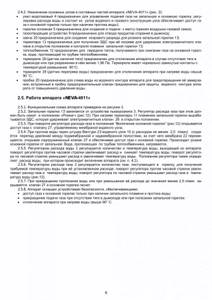
How to solve a problem
If the filter is clogged, you should remove this part from the device. Clean it with a stiff brush and water. If, during cleaning, a violation of the integrity of the filter is noticed, it is worth replacing the part with a similar one.
If the hot water pipe is clogged, you should run cold water in the opposite direction. The plug is removed, a container is placed under the device under water and both taps are turned out. The spout is closed with your finger. It is considered possible that cold water will push the clog forward.
What malfunctions do the Neva Lux dispenser have?
The display of the Neva Lux geyser indicates an error code when problems occur.
Common fault codes that also occur at the Neva Transit gas water heater:
E7. After seven attempts to turn on the device, it goes out or does not work at all. The problem lies in the failure of the electric valves, the accumulation of soot on the electrode, the mixing of the ionization sensor, or the gas block boiling. The solution is to replace faulty parts or clean the soot with a brush.
L0. Insufficient fuel supply.
Causes:
- Poor water pressure;
- Decrease in temperature;
- Exceeding the pressure of the gas water heater Neva Lux.
The problem can be solved by adjusting the temperature, installing a reduction gear and descaling the radiator.
E0. The device turned off on its own. Fuel does not move into the device. The solution is to check the gas valve of the Neva Lux gas water heater. In most cases, the gas supply stopped for some time.
E8. Malfunction related to the traction sensor. It is usually associated with a clogged chimney or a broken sensor. The solution is to clean the chimney from soot yourself or with the help of utility services, or replace the sensor with a new one, as well as check the tightness of its contacts.
Possible column malfunctions and how they can be eliminated
If you have a minor breakdown, you can fix it yourself. Here are some of them:
- After a short operation, the water heating device turns off. The reason is low traction. To do this, just clean the chimney. It also wouldn’t hurt to check the connection of the gas exhaust pipe. In the event of a malfunction, the connection must be sealed;
- If the outlet is water with a temperature above 90°. To eliminate this problem, you need to reduce the gas consumption and, on the contrary, increase the water consumption. In this way, the desired inlet temperature can be achieved;
- If when opening the tap the column does not start. To do this, you need to replace the batteries or check their installation;
- Formation of carbon deposits on the flame sensor. It needs to be cleaned;
- If the water pressure in the system is weak, then you should contact the utility service;
- If the amount of water is insufficient, the fluid flow must be adjusted;
- If scale has appeared in the heat exchanger or the filters are clogged, it is necessary to clean it;
- It is necessary to fully open the water inlet and outlet taps if they are partially open;
- If after opening the tap the column does not start, but there is a spark. In this case, it is necessary to open the gas supply valve;
- When you turn it on for the first time or after a long period of inactivity, air often appears in the communications. To solve this problem, you can open the tap for a few seconds, then close and open again. This procedure can be carried out several times;
- If a spark does not enter the gas stream. If this problem occurs, you need to adjust the distance between the burner and the spark plug electrode.
Before you start using the Neva-4511 gas water heater, you must carefully study the attached instructions. It describes in detail all possible problems and how to eliminate them. In more difficult situations, it is necessary to contact specialists.
The Neva-4511 column is an excellent inexpensive option that is produced in Russia. In addition, it has many positive aspects. This speaker is perfect for a small family.
Specifications
The range of Neva speakers is quite wide. The cost of the Neva speaker depends on the technical characteristics of the model.
- Performance. It is calculated by the volume of water heated by the device per unit of time. It ranges from 17 kW to 28 kW.
- Heat exchanger material. The service life of the object, reliability and degree of contamination depend on it.
- Pressure indicators. The lower pressure limit should not be less than 0.2 atmospheres. Otherwise the column will not work. Low water pressure is often the reason for choosing a Neva column, which operates at minimum values. The upper limit cannot exceed eleven atmospheres.
- Ignition option. Modern devices use microturbine and electronic type of column ignition. Old designs are equipped with a piezoelectric element.
- Power modulation. With its help you can change the degree of combustion intensity.
- Safety. The presence of sensors helps protect users from problems.
- Model range of geysers Neva:
Other device problems
In addition to error codes, there are other malfunctions that are also typical for the Neva Transit gas water heater:
- The appliance is too noisy. In this case, you should start turning the water regulator and reduce the pressure.
- The gaskets “stick out” in the pipe connection areas. The problem is solved by replacing the element.
- The display has stopped working. The problem lies in faulty contacts, a broken display and a faulty temperature sensor. The solution is to replace the parts and the display itself.
- The device stopped lighting up. This problem is also typical for the Zanussi gas water heater. The malfunction lies in membrane stretching, overheating and a broken device element. Solved by replacing the part with a new one.
When repairing with your own hands, it will take a long time to study the repair material and actually set up the gas water heater. The result the first time may not be the same as in the repair instructions in the literature and may even be disastrous. The best option would be to entrust the matter to professionals.
Video on geyser repair
A small addition. I found a very good video on disassembling the water block of a gas water heater. The location of components and the causes of malfunctions are shown in detail.
Be sure to check it out here:
- Repair of the power supply unit of the Tricolor GS8300 receiver Repair of the Tricolor GS8300 receiver Hello everyone. Today I will show you a solution to what turned out to be a common problem. One fine morning, while getting ready to watch TV, I was saddened […]
- Wiring out the COM9 connector.COM9 connector Below is a picture of the connector wiring. It will help determine the purpose of the terminals for repair or other [...]
- Internal optimization. Methodology: Internal website optimization Very often you can find on SEO blogs and forums that internal optimization is necessary for proper and fast website promotion. But as a rule, […]
- Types of network equipment All network equipment can be classified into two broad categories: passive and active. The passive type includes all components of the network that do not require electricity: this […]
- New from Adidas - smart watch miCoach Smart RunSmart watch miCoach Smart Run Adidas, following the release of Fitbit Force and Nike+ Fuelband SE Fitbit, has released its own product, the miCoach Smart Run smart watch on the […]
- Processor.Processor The processor is a silicon crystal grown using a special technology, which contains many individual elements - transistors. On any processor chip [...]
Principle of operation
The general principle of operation of the column follows a certain algorithm:
- Opening the water valve allows water to enter the closed water-gas unit.
- The membrane installed in it interacts with the valve.
- Opening the valve allows gas to be transported to the main burner.
- The burner is ignited using an electrode.
- Once in the heat exchanger, the water rises to the required temperature.
- Hot water is supplied to the intake point.
The use of water has no time frame. All devices of the Neva gas water heater have the same operating principle.
Source
Gas water heater NEVA 4511 - we identify and repair
The NEVA 4511 geyser is a compact water heating unit with a rated power of 21 kW. This indicator is quite enough to provide hot coolant to apartments and country houses of various sizes.
The NEVA 4511 geyser is a budget-friendly and fairly compact appliance that is convenient and easy to use. The burner flame is ignited using batteries. The built-in LCD display informs the user about the key operating parameters of the unit. The design provides for a water cooling system for the combustion chamber. The modest dimensions of the unit make the speaker invisible in any room, which can be considered as an additional plus.
The design of the NEVA 4511 geyser is quite simple, but at the same time it is not alien to modern technical achievements in matters of efficiency and safety. This model is manufactured in accordance with domestic and international requirements for equipment of this kind. This suggests that the manufacturer takes a responsible approach to the design of water heating equipment, taking care of both the consumer and its reputation in the international market.
Speaking about the design of the NEVA 4511 geyser, it should be noted that the device is designed for easy operation. The equipment starts automatically when the hot water tap is opened and goes out when the user turns off the tap. With the inexpensive and reliable speaker NEVA series 4511, you can forget about a burning wick, which can become a serious hazard. The fact that the column is powered by batteries ensures the durability of the main components and extends the life of the unit as a whole.
Advantages and disadvantages
Based on the technical characteristics and reviews of the Neva-4511 gas water heater, the following advantages can be highlighted:
- Modern speaker design.
- Acceptable price.
- Ease of use.
- Small sizes.
- It works almost silently.
- The column is equipped with a temperature indicator.
- Inexpensive spare parts.
- The speaker is convenient to turn on and off.
- A high-quality security system that meets all requirements.
- You can adjust the temperature level and water flow.
- Availability of service centers. Maintenance and repairs are available to everyone.
But the Neva-4511 column also has some disadvantages:
- Low efficiency. Foreign manufacturers produce models with higher efficiency values.
- The throughput is low. If one tap is turned on in the house, then it is not advisable to turn on the other, since the first will supply hot water.
- The outlet water temperature cannot be controlled. If the inlet water temperature increases, too hot water will come out of the tap.
- If the water is of low quality, the heat exchanger will quickly become dirty.
- To install the column, a dry wall with high-quality thermal insulation is required.
- Requires periodic replacement of batteries.
- Not everyone's gas water heater lasts long. Since the service life is affected by compliance with all rules of use, as well as the quality of equipment assembly.
Model features
Let us highlight a number of advantages that this speaker can please a potential buyer:
- Compact and ergonomic. The dimensions of the unit are very modest and amount to 565x290x221 mm. At the same time, the entire design is maintained in accordance with the best ergonomic standards - a convenient control panel and minimalistic design are characteristic features of the model.
- High performance. The design of the NEVA 4511 geyser took into account the fact that the equipment will work primarily in the difficult conditions of the Russian climate. Because of this, it was made to be hardy, strong, durable and highly productive. In addition, model 4511 is adapted to work in conditions of low pressure in the water supply system, which can be considered an important plus for users in our country, where interruptions of this kind occur quite often.
- Safety and reliability. The unit is equipped with a flame control sensor, which reduces the risk of an unexpected accident hundreds of times.
Flaws
Obviously, any domestic water heating equipment has a number of disadvantages. In this regard, the NEVA 4511 model is also far from ideal. With a rated power of 21 kW, it produces up to 11 liters of hot coolant per minute.
Experts are confident that the equipment will “not cope” with its work if water is simultaneously drawn from two points. For example, washing the dishes when someone in the household is taking a bath will not be easy. The power of the unit is not enough to provide two water points with a sufficient amount of hot water. In addition, the design does not provide for a system of smooth flame modulation, which cannot be said about more modern speakers.
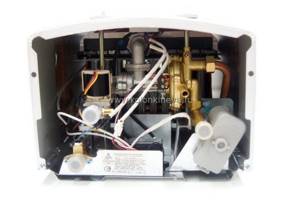
Repair
Very often on the Internet you can find requests like “do-it-yourself geyser NEVA 4511 repair.” That is why typical malfunctions and methods for eliminating them yourself will be given below.
If the column does not light up, there can be many reasons for this. Among them:
- Lack of draft in the ventilation system. The problem can be solved by cleaning the ventilation duct.
- Problems with the power supply (batteries are dead). The problem is solved by replacing the power element.
- Low water pressure in the water supply system. You can independently wash the filters, clean the column from combustion products and replace the membrane on the water unit. If the problem persists, contact the utility service with appropriate inquiries about the reason for the low pressure in the system.
- Incorrect balance between cold and hot water. In this case, you need to adjust the temperature of the coolant produced by the column so that you do not have to mix cold and hot water.
As a rule, the reason for this is that the ventilation is clogged, the power batteries are discharged, the gas supply is too intense, or the nozzle is clogged. In all these cases, it is recommended to consult a specialist. You can replace the batteries or clean the ventilation ducts yourself.
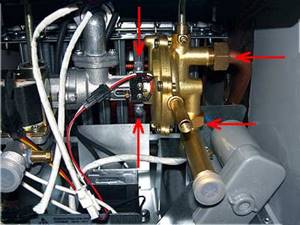
If the column turns on, but it does not heat the water to the required temperature, there may be several reasons for this. First, your equipment may not meet your power needs. Secondly, if the column is clogged, it loses performance, and this must be taken into account. You can adjust the hot coolant supply tap and call a specialist from the service center who will clean the equipment.
Expert: the service life of a geyser is significantly reduced by hard water
A gas water heater is a dangerous device, so the choice must be taken very seriously. What to look for and how to choose the option that is optimal for your premises, says Sergei Loktionov, a repairman for household gas equipment.
“Today in any specialized store you can see two types of geysers - automatic and semi-automatic,” says the expert. – The latter are essentially reminiscent of old Soviet-style speakers. We are, of course, not talking about levers and a wick that is lit from a match. Modern semi-automatic machines have a built-in piezo ignition - a spark is knocked out by pressing a button. By the way, you don’t have to turn off the button, then the auxiliary burner will smolder constantly. You just need to turn on the faucet for the main one to light up. This constant state of readiness is neither dangerous nor resource-intensive. And the output is almost automatic. But the operating principle of the automatic dispenser is different. It has built-in batteries. It is with their help that the spark is knocked out. They opened the tap and the burner flared up, closed it and it went out. You don’t need to light a wick like you would with a semi-automatic, but you will have to spend money on batteries. On average they last for a year.
In the bathroom - only semi-automatic!
Along with ease of use, there are some limitations for automatic machines. In particular, they are not recommended for use in damp areas, that is, they are not suitable for the bathroom.
The fact is that in such rooms steam constantly appears, which has a detrimental effect on all electrical parts of the device, and the batteries will oxidize. Because of this, the device will exhaust its service life much earlier.
According to the expert, machines are installed exclusively in the kitchen. And for the bathroom, semi-automatic devices with piezo ignition are more suitable. There are no electronics or batteries, so moisture and steam are not a problem for such a speaker.
The more powerful the better?
One of the most important indicators that you need to pay attention to when choosing a geyser is the thermal power. All units are divided into: low power speakers - from 7 to 19 kW, medium - from 22 to 24 kW and high power - from 28 to 30 kW.
– The volumetric flow rate of water also depends on the power. Therefore, it’s easier to first decide on the consumption, and then select the power depending on it,” advises Sergei Loktionov. – Consumption is calculated in liters of water, which the column can heat to a certain temperature in one minute. On average, for a family of 1-2 people, with a small amount of water consumed, the productivity is 7 l/min. will be quite enough. For a house where 2-3 people live, you need 9 l/min; column with a capacity of 10-12 l/min. suitable for a family of 3-4 people; but the optimal indicator for five or more people is no less than 14-15 l / min.
When selecting the performance and power of the column, it is also necessary to take into account the water pressure in the pipe. If it is 5 liters per minute, then the column will not heat more than this volume, it will only boil. If the burner is too powerful in the summer (when the water is already warm), it will heat up to such a high temperature that it will be impossible to use it.
According to the master, the average dispenser displacement at normal water pressure (and it is enough for a family of 3-4 people and two water intake points - a bathroom and a kitchen) is 10-12 l / min, which corresponds to a power of 22-24 kW.
By the way, another option to determine productivity is to count the number of water intake points. It is believed that one mixer is capable of flowing about 6 liters per minute. If a gas water heater is installed in a small apartment where two mixers are installed - in the bathroom and in the kitchen, then in order to use them simultaneously, you need a device with a capacity of at least 12 l / min. But for cottages, for example, where the mixer is located in the kitchen, two bathrooms and a shower, you will need a column with a displacement of at least 15-16 l/min. This parameter is usually indicated on a special plate on the product body or in the device passport.
From a security point of view
First, you need to make sure that all the necessary conditions for the functioning of the gas water heater are met: effective supply ventilation, a properly functioning exhaust hood, a properly constructed chimney, and adequate draft. This should be checked by specialists. The connection of the gas water heater must be entrusted to a specialist licensed to carry out such work. It is also necessary to pay attention to the safety devices built into the device.
“Currently, all dispensers have traction overturn protection, that is, a traction sensor,” says Sergei Loktionov. – If the draft is bad or even reversed, he turns off the column. It is good when there is also an overheat sensor. It is triggered when the water pressure decreases. Semi-automatic machines have a thermocouple, which, based on the burning wick, keeps the valve open. As soon as the wick goes out (it blows out, the gas is turned off, and the person is not at home), then the thermocouple is no longer in the flame, it turns off the gas valve, and the gas is shut off.
How long will it last?
The service life of a geyser depends primarily on the quality of the water. This, according to the master, is the most important thing that affects its durability. The harder the water, the faster the internal parts of the device wear out. Scale remains on the parts of the column heat exchanger and renders them unusable. Therefore, in the private sector, if water comes from a well without treatment, as in the central water supply network, it is recommended to purchase the cheapest gas water heater: there is no point in buying a more expensive option. The unit will still have to be replaced pretty soon.
As for manufacturers, there are a lot of them on the market now - these include Chinese speakers, which occupy most of it, and European and domestic ones. In any case, you need to select a unit with parameters that correspond exactly to the room where it will be used. And, if the choice is made correctly, and all connection conditions are met, then at the moment of startup it will be immediately clear whether the device is working or not. The average service life of a geyser with proper operation is about 12-15 years.
| power, kWt | When heated by 25 °C from the initial incoming temperature |
| 19 | Up to 11.5 l/min. |
| 24 | Up to 14 l/min. |
| 28 | Up to 16 l/min. |
Modern dispensers are equipped with sensors that turn off the gas supply in the event of a malfunction. But it is important to correctly calculate the power of the unit for your premises.
